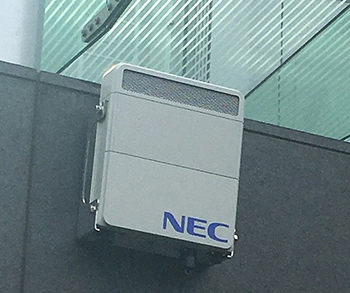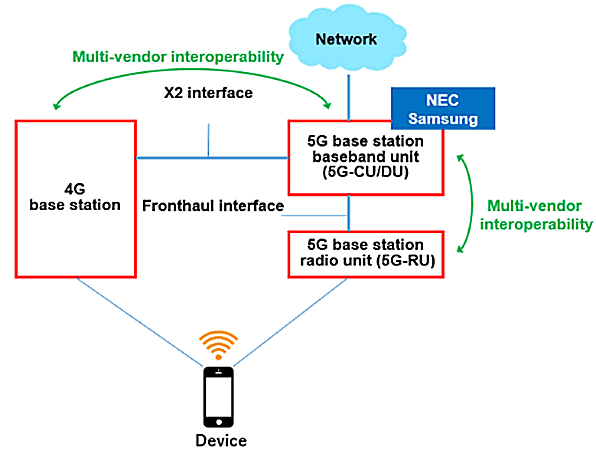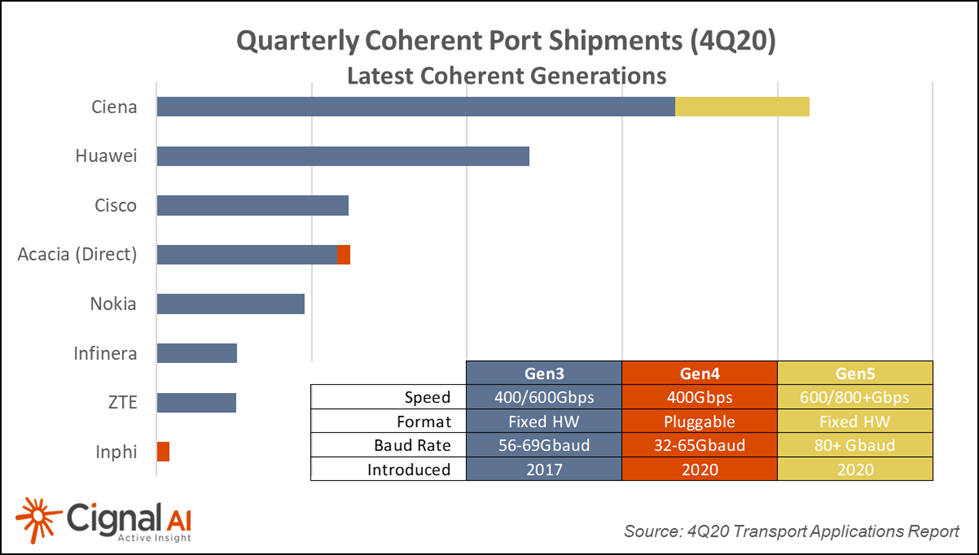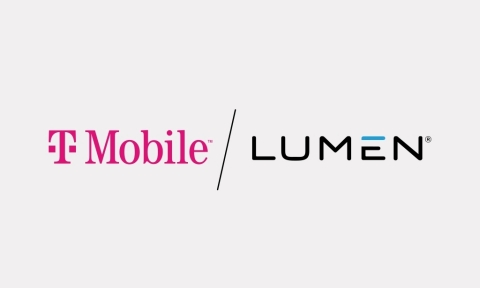Month: April 2021
NEC and Cisco in Global Systems Integrator Agreement for 5G IP Transport
NEC Corp and Cisco today announced they have entered into a Global System Integrator Agreement (GSIA) to expand their partnership for accelerating the deployment of innovative 5G IP transport network solutions worldwide.
[Will any other protocol besides IP operate over 5G data plane?]
Under the agreement, the companies will jointly drive new business opportunities for 5G. NEC group companies will work closely with Cisco to complement NEC’s ecosystem with optimized IP metro/access transport and edge cloud computing solutions. Cisco will support NEC’s customer engagements by offering best-in-class products, proposals and execution support.
The new agreement underlines NEC’s successful track record as a Cisco Gold Partner over two decades, and its proven engineering capabilities to provide Cisco products to its global customer base across multiple regions.
“We believe 5G is fueling the internet for the future, and accelerating our customers’ digital transformations,” said Jonathan Davidson, Senior Vice President and General Manager, Mass-Scale Infrastructure Group, Cisco. “Together with NEC, we are creating a powerful force to drive the critical changes needed in networking infrastructure to carry the internet into the next decade.”
“Collaboration across the network solution ecosystem is essential for continued success in meeting diversified customer requirements and establishing a win-win relationship,” said Mayuko Tatewaki, General Manager, Service Provider Solutions Division, NEC Corporation. “This powerful partnership strengthens our global competitiveness as a network integrator that drives the customer journey with innovative solutions.”
NEC and Cisco say they will make collaborative efforts to further enhance their joint solution portfolio and to optimize regional activities for advancing the digital transformation of customers across the globe. Indeed, NEC has a long history of working with Cisco stretching back more than two decades. This includes the two working together on 4G LTE equipment that combined NEC’s RAN and backhaul assets with Cisco’s network equipment.
The two firms last year bolstered efforts in ensuring the security of their networking equipment. This involved using NEC’s blockchain technologies and Cisco’s fraud detection technologies to confirm the authenticity of network equipment used for security and critical industrial infrastructure before it was shipped to a customer, during the construction of those networks, and during operation.
NEC also participated in Rakuten Mobile’s 4G-LTE network deployment in Japan. NEC has so far gained the most from that deployment as it’s been tapped to provide a standalone (SA) 5G core network based on the specification it wrote with Rakuten Mobile.

NEC recently established an Global Open RAN Center of Excellence in the UK, which aims “to accelerate the global adoption of Open RAN and to further strengthen its structure for accelerating the global deployment of 5G.”
The company also developed (with Samsung) and demonstrated an O-RAN Alliance compliant 5G base station baseband unit (5G-CU/DU) on NTT DOCOMO’s commercial 5G network.

Source: NEC Corp.
………………………………………………………………………………………………………………………………….
Cisco was initially part of Rakuten Mobile’s 4G-LTE deployment, but has been conspicuously absent from the Japanese carrier’s more recent 5G plans. Cisco has been steadily bolstering its 5G focus with updates to its routing and networking equipment. This includes updates earlier this year to its router portfolio, and scoring a deal late last year with AT&T to assist with disaggregated IP routing technology for an edge routing platform.
Cisco has also been working with Japanese carrier KDDI on its 5G and network virtualization efforts. This included a proof-of-concept (PoC) last year that demonstrated cloud-native software with Cisco’s Ultra Packet Core platform.
Nonetheless, Cisco continues to lag behind the more established telecom vendors in providing 5G equipment. They don’t make cellular base stations which limits their offerings to routers with 5G interfaces.
A recent Dell’Oro Group report placed Cisco a distant No. 5 among overall telecom equipment vendors, with its market share having shrunk by 1% from 2019 to 2020 to only 6%.
| Top 7 Suppliers | Year 2019 | Year 2020 |
| Huawei | 28% | 31% |
| Nokia | 16% | 15% |
| Ericsson | 14% | 15% |
| ZTE | 9% | 10% |
| Cisco | 7% | 6% |
| Ciena | 3% | 3% |
| Samsung | 3% | 2% |
Source: Dell’Oro Group
………………………………………………………………………………………….
References:
https://www.nec.com/en/press/202104/global_20210408_01.html
https://www.sdxcentral.com/articles/news/cisco-nabs-nec-to-expand-5g-reach/2021/04/
https://www.delloro.com/key-takeaways-total-telecom-equipment-market-2020/
Coherent WDM shipments surged in 4Q20 with Ciena in the lead; 400 ZR explained
|
||
 |
||
Note 1. What is 400ZR?
Aimed predominantly at short-reach, single-span fiber optic links for Data Center Interconnect (DCI), 400ZR is an interoperable networking Implementation Agreement (IA) released by the OIF (Optical Internetworking Forum) in March 2020. It defines a footprint-optimized solution for transporting 400Gb Ethernet over DCI (Data Center Interconnect) links targeting a minimum of 80 km. Enabled by advanced coherent optical technology design targeting small, pluggable form factor modules such as QSFP-DD and OSFP, 400ZR supports high capacity data transport, matched to 400GE switch port market introduction.
……………………………………………………………………………………………………………………………………..
Comments on 400ZR:
The main driver for 400ZR were the cloud giants (AKA hyperscalers) who needed to upgrade their DCI links to 400G b/sec to carry ever increasing data and video traffic. Yet they were very slow to do so, despite IEEE 802.3bs 200/400G b/sec Ethernet standard and 40G b/sec ITU-T OTN recommendations (Optical Physical Interfaces G.959.1, G.695, G.698.x) in place for many years. Up until last year, Ciena was the only optical networking equipment vendor that offered production ready 400G b/sec DWDM gear.
Light Reading’s Sterling Perrin wrote: “Although 400ZR work within the OIF began with hyperscalers, there is already evidence that the architecture also appeals to CSPs (communications service providers).”
“Sweden’s Telia Carrier, Ethiopian internet service provider WebSprix and Windstream in the US have all announced plans to commercial deploy routed optical networks using 400G pluggable coherent optics beginning this year.”
………………………………………………………………………………………………………………
References:
https://cignal.ai/free-articles/
https://www.ciena.com/insights/what-is/What-is-400ZR.html
https://www.itu.int/en/ITU-T/studygroups/2017-2020/15/Documents/OFC2018-1-SG15-Hot-topics-OTN.pdf
https://www.lightreading.com/opticalip/routing/an-ip-over-dwdm-renaissance-at-400g/a/d-id/768513
Lumen Technologies and T-Mobile collaborate on edge compute for enterprise customers
Following this week’s Verizon-AWS announcement on Multi-access Edge Computing (MEC), T-Mobile US has entered the mobile edge computing business using wireline carrier Lumen Technologies (formerly CenturyLink) as its initial preferred vendor.
T-Mobile US has taken a decidedly different MEC approach compared to its two domestic rivals (Verizon and AT&T). The U.S.’s #2 wireless network operator effectively views the edge as a latter opportunity that doesn’t merit a large initial investment. Its edge computing initiatives are exclusively focused on businesses and government agencies that fall under Lumen’s enterprise unit and T-Mobile for business.
“By pairing America’s largest and fastest 5G network with Lumen’s enterprise solutions, we can break down industry barriers and deliver unparalleled network reach to enterprise and government organizations looking to optimize their applications across networks,” Mike Katz, EVP for T-Mobile for Business, said in a prepared statement. “With our leading 5G network, Lumen and T-Mobile have the opportunity to accelerate business innovation in an era where the network is more critical than ever,” Katz added,

Enterprise applications will likely benefit from Lumen’s hundreds of thousands of fiber connected enterprise locations paired with T-Mobile’s “largest and fastest 5G network.”
“The Lumen platform, with 60 plus planned edge market nodes distributed on our high-capacity global fiber network enables application designs with latency of 5 milliseconds or less between the workload and the endpoint device,” wrote David Shacochis, VP of enterprise technology and field CTO at Lumen.
“Lumen’s fiber reach and edge computing resources can augment business solutions for T-Mobile customers, and private wireless solutions can augment business solutions for Lumen customers,” Shacochis added.
“The companies envision starting with metropolitan areas where they are already well connected, and expanding their joint go-to-market over time,” Shacochis wrote, adding that more details about commercial availability and services will be shared throughout 2021.
These efforts aim to address the pressing needs of enterprises to transform their networks to meet the data-intensive challenges across a variety of industries and use cases. Both companies will also continue to drive innovation in this space through T-Mobile’s labs and Tech Experience Center and the Lumen Edge Experience Center.
“Our relationship with T-Mobile aims to introduce a powerful trifecta – access to national 5G wireless and fiber connectivity, managed services across a range of technologies and edge computing resources,” said Shaun Andrews, executive vice president and chief marketing officer for Lumen Technologies. “T-Mobile’s expansive 5G footprint coupled with our extensive edge computing platform would provide enterprise developers with the best of both worlds to power the next wave of digital business.”
- For a current list of Lumen live and planned edge locations, visit: https://www.lumen.com/en-us/solutions/edge-computing.html#edge-computing-map
- The Lumen low latency network is comprised of approximately 450,000 global route miles of fiber and more than 180,000 on-net buildings, seamlessly connected to:
- 2,200 public and private third-party data centers in North America, Europe & Middle East, Latin America, and Asia Pacific
- Leading public cloud service providers including Amazon Web Services, Microsoft Azure ExpressRoute & Azure Government, Google Cloud, IBM Cloud and Oracle Cloud
T-Mobile’s partnership with Lumen is likely just the beginning. “As in all things with 5G, I think a lot of our efforts have to be done through partnerships,” said John Saw, EVP of advanced and emerging technologies at T-Mobile. Apparently, the network operator will form partnerships with many of the big vendors in the space, including hyperscalers (Google, Amazon, Microsoft), and other specialized mobile edge computing vendors.
Similarly, Shacochis said Lumen is also “open to and looking at” other partnerships in the wireless space. Lumen executives outlined a plan to offer edge compute services in August 2019. The company deployed its first block of edge nodes and obtained its first customer in Q3-2020, before formally launching its edge platform in December 2020.
Building on cloud partnerships with Microsoft Azure, Google Cloud and Amazon Web Services (AWS), Lumen bolstered its edge capabilities through additional deals with VMware and IBM.
…………………………………………………………………………………………………………………………….
References:
https://www.sdxcentral.com/articles/news/lumen-lands-t-mobiles-first-5g-edge-contract/2021/04/
https://www.fiercetelecom.com/telecom/lumen-strikes-edge-compute-deal-t-mobile
https://www.sdxcentral.com/edge/definitions/multi-access-edge-computing-vendors/
IBM and Verizon Business Collaborate on 5G, Edge Computing and AI Solutions for Enterprise Customers
Amazon AWS and Verizon Business Expand 5G Collaboration with Private MEC Solution
AWS and Verizon Business have expanded their 5G collaboration to provide private multi-access edge computing (Private MEC) for enterprises. Private MEC integrates edge computing infrastructure with private networks deployed on or near the customer’s premises. AWS and Verizon have integrated Verizon’s 5G Edge MEC platform with AWS Outposts [1.], a fully managed service that offers the same AWS Infrastructure, AWS services, APIs, and tools to virtually any data center, colocation space, or on-premises facility for a consistent, hybrid experience.
Note 1. Outposts is AWS’ on-premises option that involves data center equipment being installed at an enterprise facility. It uses AWS infrastructure, services, APIs, and tools to support a hybrid cloud service. Verizon is offering several form factor options of Outposts, include 1U and 2U deployments.
AWS initially launched Outposts in late 2019. “Instead of building this funky bridge between two things,” on-premises data centers and the cloud, Outposts brings native AWS services into on-premises data centers while “seamlessly connecting to AWS’s broad array of services in the cloud,” AWS CEO Andy Jassy explained at the time.
Outposts is similar to competing offers like Microsoft’s Azure Arc, Google’s Anthos, and IBM’s Cloud Satellite. AWS last month also struck a deal with Nokia to combine Outposts with the telecom vendor’s RAN and edge equipment to target the enterprise space.
………………………………………………………………………………………………………………………………………
Verizon Business customers will be able to tap into the combination to deploy a fully managed private mobile edge compute network within their on-premises environment that can handle low-latency applications like intelligent logistics, robotics, and factory automation.

MEC deployment across different enterprise networks. Source: ETSI
…………………………………………………………………………………………………………………………………….
According to Amazon, cloud migrations are often inhibited by residency or privacy constraints that prevent data from leaving the premises, strict compute latency requirements, or the need for cloud infrastructure to connect directly to onsite equipment. Similarly, many workloads involve huge volume of data, making transfers to the cloud infeasible due to limited available network bandwidth and timing constraints.
Furthermore, enterprise applications commonly depend on local wired or Wi-Fi networks to transport data locally. While wired networks can provide acceptable performance, they are expensive to upgrade, reroute, and extend. On the other hand, enterprise Wi-Fi offers simplicity and cost-effectiveness, but offers less manageability and suffers from coverage, capacity, reliability, security, and handoff issues.
The Private MEC solution deployed on AWS Outposts addresses these challenges by providing a secure, dedicated cloud computing platform and reliable on-premises wireless networking based on 5G, all using a single infrastructure deployment. The private 5G network offers better performance, control, reliability, and density than existing options. Combined with the AWS services brought by AWS Outposts, we are enabling Enterprise customers to deploy low latency, high-performance applications on their premises, leveraging both the benefits of 5G and the cloud, locally. By leveraging Private MEC enterprises can host workloads in emerging areas such as Industry 4.0; for example, Private MEC and private 5G can facilitate deeper integration between IT and operational technology (OT) systems in manufacturing facilities.
Private MEC also supports many use cases beyond the factory. Events and venues, such as sports, concerts, and theme parks can use Private MEC to provide enhanced experiences with AR/VR, live information overlays, multi-camera, multiple angle views, and personalized instant replays. Healthcare providers use Private MEC for real-time diagnostics over 5G for rapid access to radiological scans on-site and local processing of sensitive patient data. Schools and universities can benefit from Private MEC by servicing students in rural areas without adequate broadband coverage to run applications like virtual desktops. We are excited about the innovations that Private MEC solutions can unlock across industries, and continue to work with customers to power their innovation with edge computing.
……………………………………………………………………………………………………………………………………………
Amazon AWS is also working with Corning Incorporated, a leading materials science and advanced manufacturing innovator, and Verizon to deploy a Private MEC solution on AWS Outposts at the Corning factory in Hickory, North Carolina. Corning uses AWS Outposts to run computer vision software from Gestalt Robotics that provides autonomous navigation and advanced environmental sensing. Corning recently installed an AWS Outposts rack that places the power of the AWS cloud within the four walls of its optical cable plant in Hickory, North Carolina.
The AWS capabilities that Outposts delivers, combined with the ultra-low latency, high throughput of the private 5G network, provide a powerful platform upon which Corning will innovate with applications never before possible, such as real-time analysis of large volumes of high-resolution video streams from across the factory and integration of high-data-rate automation systems. In factory environments like this, Amazon EC2 instances with GPU acceleration provide the necessary computing power to run Computer Vision (CV) and AI/ML workloads efficiently, enabling real-time control of Autonomous Mobile Robots (AMRs) that roam the factory floors.
The software running on the Private MEC service can guide the AMRs safely and speedily through a factory, avoiding people and obstacles while ferrying their payloads from point to point. The Private 5G network enables reliable, low-latency transmission of rich sensor data (lidar, vibration, temperature, audio) from these AMRs and other industrial devices located throughout the factory. Importantly, this enables operators to observe a live stream of video in near real-time and intervene when necessary.
The same computer vision technology used by the AMRs for navigation and safety can also be used to detect and inventory raw material and finished goods in a factory. Mobile video streams from the AMRs can be combined with feeds from cameras installed in the factory and onsite sensor inputs and RFIDs for accurate counting and tracking. In addition, integration with Manufacturing Execution Systems (MES) running on Outposts enables real-time monitoring, automation, and optimization, as raw material is turned into the final product.
This opens up possibilities such as performing predictive maintenance and servicing of onsite machinery without the need to ship massive amounts of sensor data over network links into the cloud. Private MEC solutions like this enable factories to become even smarter and leverage the power of innovation that AWS brings to the cloud, while simplifying the deployment and management of on-premise networking with the latest 5G technologies.
References:
https://aws.amazon.com/outposts/
https://www.sdxcentral.com/articles/news/verizon-adds-aws-outposts-to-5g-edge-plan/2021/04/
https://www.etsi.org/images/files/ETSITechnologyLeaflets/MultiAccessEdgeComputing.pdf
Spain’s Government tests 5G at 700 MHz for potential interference with Digital TV
5G in 700 MHz Interference Tests:
The Spanish government has begun a series of trials to ensure that the country’s forthcoming 5G services in the 700 MHz band will not interfere with DTT (Digital Terrestrial Television) transmissions, reports website Voz Populi.
The tests are being conducted on Movistar (Telefonica), Vodafone and Orange infrastructure in the Ciudad Real in the central Castilla La Mancha region, with Huawei, Nokia and Ericsson as the 5G network equipment suppliers.

Image Credit: Europress
…………………………………………………………………………………………………………………………………………..
Spain’s government is finally prepared to auction frequencies in the 700 MHz band [1.] before the end of May, having delayed the tender several times due to the Covid-19 pandemic. The eight blocks of 20-year frequencies will have a starting price of EUR 1.17 billion and the ministry said it was looking to raise at least EUR 2 billion, although operators have called on the government to cut the price due to already high tax burdens and with a view to boosting investment.
Note 1. Before the auction of the 700 MHz band takes place (it has been delayed again for the third time due to the COVID-19 pandemic), it is necessary to know that the technology does not interfere with other bands and services, as is the case with the TDT.
–>Please see section below on 5G Auction Delay.
Spain finally completed its second digital dividend plan to free up the 700 MHz band for 5G services at the end of last year after it was suspended in mid-March due to the first coronavirus lockdown.
Anonymous sources involved in the test told Vozpópuli:
“This is what the protocol dictates. First, the 700 MHz band of television channels has been cleaned up, something that happened in October last year, and the spectrum blocks occupied by the Ministry of Defense in the 3.5 GHz band. Now the procedure to follow is to carry out tests to see the behavior of 5G technology with others that also use radioelectric spectrum. This is precisely what is being done now.”
The same sources explained that the tests are currently being carried out with total normality. Furthermore, the coexistence between 5G and digital television does not seem to present problems, i.e. there has been no interference detected to date.
Implications of the 5G Auction Delay:
The delay in the 5G auction is good news for some, and bad for others. For network operators it is a breath of oxygen due to their financial and market situation. The billing of the telecommunications majors is frozen. The 5G auction supposes, from the outset, the payment of billions of euros. The bid is set, according to the General State Budgets, at 2,000 million euros, although operators suspect that this amount will rise by 10% more.
Deployment cost must be added to this spectrum auction investment. Once the specific spectrum blocks that each operator are determined, the infrastructure can be deployed. That will likely be in billions of Euros.
Vozpópuli Editorial Comment:
“The development of 5G does not seem peremptory in need. The reality is that there are no services to be delivered with this (5G) technology that the user can exploit with a connection up to 100 times faster than that offered by 4G.”
………………………………………………………………………………………………………………………………….
References:
https://www.vozpopuli.com/economia_y_finanzas/5g-pruebas-tdt-television.html
https://www.telecompaper.com/news/spain-conducting-5g-dtt-interference-tests-on-700-mhz-band–1378248
https://techblog.comsoc.org/2020/12/02/spains-plan-to-bring-ftth-and-5g-to-its-entire-population/
Verizon Business wins Private 5G contract in the UK
Verizon Communications Inc. won a contract to erect and operate a private 5G network in Southampton, England (United Kingdom), for Associated British Ports Holdings, its first industrial 5G award in Europe. The #1 U.S. wireless telco beat out local telecommunications companies and is jump starts a push to sell the wireless systems to global businesses.
- Verizon teams up with Nokia to offer private 5G capabilities to enterprises in Europe and Asia-Pacific
- Private 5G will enable organizations to deliver mission critical and real-time capabilities
- Announcement marks Verizon’s continued investment in 5G and network-as-a-service strategy
A private 5G network is a self-contained network whose components all reside in a single facility, consisting of micro towers and small cells and connects to an organization’s Local Area Network (LAN) and enterprise applications. It will utilize Nokia’s Digital Automation Cloud, a private wireless network solution with automation enablers that will allow for application deployment through a web-based interface.
New York-based Verizon opened a showroom in London last year and spoke about its hopes to muscle in on 5G enterprise deals beyond the U.S. It’s a sign competition is heating up in the segment, seen as a key way to fuel growth in the otherwise stagnant telecommunications sector for local carriers like Newbury, England-based Vodafone Group Plc.

“We chose Verizon simply just due to the track record within setting up private 5G networks,” said Henrik Pedersen, chief executive officer of ABP, in a video call with Bloomberg. “Regional or local, I don’t see it like this. I see 5G as a global thing.”
Southampton is a crucial British terminal which usually handles about 900,000 cars and sees millions of cruise ship passengers per year. It’s upgrading its network as the port adapts to its new status as a freeport, one of several low-tariff business zones on the British coast that U.K. chancellor Rishi Sunak unveiled last month as part of his plans to stimulate post-Brexit trade.
Verizon’s 5G network will remove dead spots and increase bandwidth at the port, ultimately enabling new systems, such as using drones that can transmit high-definition video for maintenance checks, and sending live shipping data, Pedersen said.
“There’ll be a lot of need for data transfer in the future in the freeport zone, and especially when you start to move goods in and out of the customs zones,” said Pedersen. He said he wants the system up and running by July, and added that more of ABP’s 21 ports are likely to get 5G networks in the future.
“Today, we’ve announced the next phase of Verizon’s global 5G vision with the launch of private 5G for our international customers,” said Tami Erwin, CEO, Verizon Business. “If the past few months have taught us anything, it’s that there’s never been a more critical time for mobility, broadband and cloud products and services. Private 5G networks will be a transformative technology that will drive the new era of disruption and innovation for enterprises around the world.”
“Private wireless connectivity has become central to many industries in realizing their long-term digital transformation goals. By delivering private 5G together with Verizon, we’re paving the way to accelerate digitalization for the most demanding industries who crave reliable wireless connectivity,” said Brian R. Fitzgerald, SVP Global Solutions at Nokia.
“We’re seeing international markets moving rapidly to deploy 5G Private Networks, which appears as a major use case for the uptake of 5G, particularly in order to capitalize on 5G investments in the enterprise market. With the ingredients of an early mover go-to-market 5G-know-how, foundational enterprise networking and innovative 5G enabled services Verizon’s go-to-market recipe with Nokia will be an attractive solution to the broader market,” said Martina Kurth, associate vice president of IDC’s European Telco Research practice.
Today’s announcement follows recent MEC partnership announcements with Microsoft, Cisco, IBM and AWS. In August, Verizon recently announced its successful completion of lab trials with Corning and Samsung on its new 5G mmWave in-building solutions.
………………………………………………………………………………………………………………………………
References:
https://www.verizon.com/about/news/verizon-business-takes-private-5g-global
https://www.bnnbloomberg.ca/verizon-beats-out-european-carriers-to-run-5g-at-u-k-freeport-1.1585233


